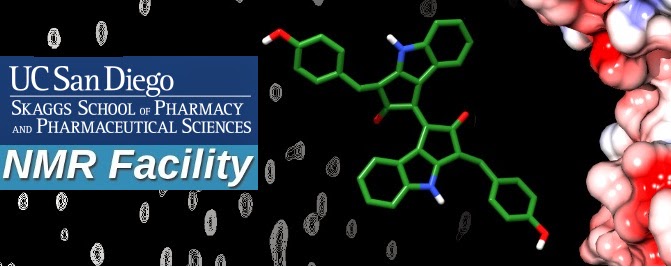Recording an NMR spectrum requires working through a series of steps, one of which is "locking", but what exactly is locking? Locking is monitoring one of the NMR signals in a sample so that any fluctuations in the strength of the magnetic field can be compensated for.
Tuesday, December 4, 2018
Friday, November 2, 2018
Probes
In an NMR spectrometer the probe is the piece of equipment that holds the sample and detects the signals from it. This post will give an overview of probe design and the various types of probes available.
Thursday, October 4, 2018
What is a quench?
Since last month's incident several people have asked, "What is a quench?" To answer this, and give some idea of its causes, we need some understanding of how a superconducting magnet is constructed.
Friday, September 7, 2018
Suppressing zero quantum artifacts
In the previous post zero quantum artifacts in NOESY spectra were described. Misintrepretation of these artifacts can lead to errors in structure elucidation. A method for suppressing zero quantum artifacts has been developed1 and it is quite effective.
Tuesday, August 7, 2018
Zero quantum artifacts in NOESY spectra
Unlike most other NMR experiments that correlate resonances via J-coupling through bonds, the NOESY experiment correlates resonances via cross-relaxation through space. Since the intensity of the correlation is strongly dependent on the distance between the interacting nuclei, the intensity of the NOE peak is related to the distance between the atoms. This makes the NOESY experiment very useful for determining three dimensional structures and assigning stereochemistry. However, interpreting NOESY spectra has to be done carefully, as artifacts due to zero-quantum transitions are often observed.
Wednesday, July 18, 2018
Magnitude processing
Most modern NMR experiments are run in a phase sensitive mode, which means that after fourier transformation the peaks require phase correction to become all positive. The HMBC experiment, however, generates signals that cannot all be phased simultaneously. The commonly used solution is magnitude processing.
Wednesday, June 6, 2018
Linewidth titrations
NMR is one of the most powerful techniques to monitor molecular interactions because of the wealth of information it provides. The previous post described monitoring chemical shift changes during titrations, but chemical shifts are not the only NMR parameter that can change during titrations. Often linewidths change as well. By measuring linewidth changes the dissociation rate, koff, may be determined.
Tuesday, May 15, 2018
Chemical shift titrations
NMR is one of the most useful techniques for monitoring molecular interactions. It is particularly useful for characterizing weakly interacting systems. Typically, weakly interacting systems produce spectra that are in fast exchange, i.e. the NMR observables are detected as population weighted averages. By manipulating the populations, through changing concentration for example, a series of spectra can be obtained from which information like the dissociation constant (KD) and the dissociation rate (koff) may be determined. Titrating one molecule with another and monitoring the chemical shift changes is a common method for determining KD.
Thursday, April 5, 2018
Dynamic NMR
NMR is one of the few techniques that can provide dynamic information at the atomic level. It is able to do this because NMR parameters, like chemical shift, coupling constants and relaxation rates, are influenced by the immediate atomic environment. If the environment changes, then these NMR parameters are likely to change as well. The rate at which the environment changes affects how the NMR parameters appear in a spectrum. If the change is slower than the time taken to record that parameter then it is called "slow exchange", and multiple values of the NMR parameter are recorded. If the change happens faster than the time taken to record it then it is referred to as "fast exchange", and an averaged NMR parameter is detected. As an example, the temperature dependent chemical shifts of the thyroid hormone thyroxine are discussed below.
Friday, February 2, 2018
Homodecoupling
Homodecoupling is a technique for selectively removing coupling in 1D NMR spectra. Often 1D 1H spectra show complex splitting patterns that are difficult to interpret. Selectively eliminating one coupling may allow a multiplet to be interpreted or enable measurement of couplings that could not otherwise be quantified. Recently, we used homodecoupling to assign the stereochemistry of a pair of enantiomers.
Wednesday, January 10, 2018
Gradients for measuring diffusion
Translational diffusion, also known as Brownian motion, is the random motion of particles among the other components of a solution. The rate of diffusion is related to the size of the molecule so measuring this rate can provide an estimate of molecular weight and information on aggregation, or binding, at close to physiological conditions. NMR experiments have been devised to measure translational diffusion using a pair of gradient pulses separated by a delay. These Diffusion Ordered SpectroscopY, or DOSY1, experiments, are typically shown as 2D spectra with a horizontal 1H dimension and a vertical diffusion rate dimension.
Subscribe to:
Posts (Atom)
